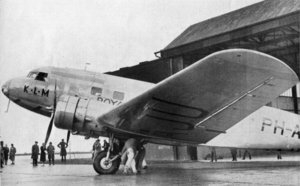Douglas DC-2
|
|
| Douglas DC-2 | ||
|---|---|---|
 DC-2 PH-AJU came second in the MacRobertson Air Race | ||
| Description | ||
| Role | Passenger & military transport | |
| Crew | 2-3 | |
| Passengers | 14 | |
| First flight | May 11, 1934 | |
| Entered service | May 18, 1934 | |
| Manufacturer | Douglas Aircraft Company, Fokker | |
| Dimensions | ||
| Length | 62 ft 6 in | 19.1 m |
| Wingspan | 85 ft 0 in | 25.9 m |
| Height | 15 ft 10 in | 4.8 m |
| Wing area | 940 ft² | 87.3 m² |
| Weights | ||
| Empty | 12,455 lb | 5,650 kg |
| Loaded | 18,560 lb | 8,420 kg |
| Maximum takeoff | lb | kg |
| Powerplant | ||
| Engine | 2 × Wright Cyclone GR-F53
| |
| Power (each) | 730 hp | 540 kW |
| Performance | ||
| Maximum speed | 210 mph @ 6,800ft | 338 km/h @ 2,070 m |
| Combat range | 1,085 miles | 1,750 km |
| Ferry range | km | miles |
| Service ceiling | 22,750 ft | 6,930 m |
| Rate of climb | 1,030 ft/min | 310 m/min |
The Douglas DC-2 was a 14 seat, twin-propeller airliner produced by the Douglas Aircraft Corporation starting in 1934. It competed with the Boeing 247. In 1936 Douglas produced a larger version called the DC-3, which became one of the most successful airplanes in history.
In the early 1930s safety fears about wooden structured aircraft (implicated in the crash of a Fokker tri-motor which killed Knute Rockne) led the American aviation industry look to implement aircraft of all-metal construction. With United Airlines having a monopoly on the Boeing 247, the rival Transcontinental and Western Air issued a specification for an all-metal trimotor.
The response of the Douglas Aircraft Company was more radical. When it flew on July 1, 1933, the prototype DC-1 had a highly robust tapered wing, a retractable undercarriage, and only two 690 hp (515 kW) Wright radial engines driving variable-pitch propellors. It seated 12 passengers.
TWA accepted the basic design, and placed an order for 20 DC-2s, with more powerful engines and seating 14 passengers. The design impressed a number of American and European airlines and further orders followed. Those for European customers KLM, LOT, Swissair, CLS and LAPE were assembled by Fokker in the Netherlands.
Although overshadowed by its ubiquitous successor, it was the DC-2 which first showed that passenger air travel could be comfortable, safe and reliable. As a token of this, KLM entered their first DC-2 PH-AJU Uiver (Stork) in the October 1934 MacRobertson Air Race between London and Melbourne. Out of the 20 entrants, it finished second behind only the purpose built de Havilland DH.88 racer Grosvenor House. During the total journey time of 90 h 13 min, it was in the air for 81 h 10 min.
156 DC-2s were built.
Modified DC-2s were built for the Army Air Corps under several military designations:
1 C-32 flying command post
18 C-33 cargo transport with hinged cargo door in aft fuselage
2 C-34 VIP transport
1 C-38 modified from C-33 with DC-3 style tail section, Wright R-1820-45 radials of 930 hp (694 kW) each
35 C-39, a composite of DC-2 & DC-3 components, Wright R-1820-55 radials of 975 hp (727 kW) each
1 C-41 VIP transport, Pratt & Whitney R-1830-21 radials of 1200 hp (895 kW) each
1 C-42 VIP transport, Wright R-1820-53 radials of 1200 hp (895 kW) each, plus two similar converted C-39s.
24 Commercial DC-2s impressed at the start of World War II were designated C-32A.
Survivors
Nowadays, there are no more DC-2s in commercial service. However, at least 3 aircraft made it into the 21st century:
- c/n 1404: The Aviodrome museum (http://www.aviodrome.nl/) in Lelystad, the Netherlands owns the last flying DC-2. This former US Navy aircraft is painted in the Uiver's KLM colour scheme and is sometimes seen on airshows in Europe.
- c/n 1368: A former Pan Am aircraft that was used by the Douglas historical foundation until the merger with Boeing in 1997. Now it is in storage at Long Beach.
- c/n 1288: There is a second aircraft in the Netherlands, owned by the Dutch Dakota Association. It is far from airworthy and a lot of work needs to be done before it is. Its first operator was Eastern Air Lines.
External links
- DC-2 Article (http://www.daveswarbirds.com/usplanes/aircraft/dc-2.htm)
- Centennial of Flight Commission on DC-1 and -2 (http://www.centennialofflight.gov/essay/Aerospace/Douglas-1930s/Aero28.htm)
- DC-2 Article (http://www.rcaf.com/1939_1945_waryears/aircraft/transports/dc2/)
- DC-2 (http://www.planefacts.co.uk/cards/douglas/pages/douglas_dc2_jpg.htm)
- DC-2 Image (http://1000aircraftphotos.com/Contributions/Coates/2220.htm)
- Airliners.net DC-2 Images (http://www.airliners.net/search/photo.search?aircraft_genericsearch=Douglas%20DC-2%20(C-39%2F42%2FR2D)&distinct_entry=true)
- Dc-2 Images (http://users.chariot.net.au/~theburfs/dc2MAIN.html)
| Related content | |
|---|---|
| Related development | Douglas DC-3 - B-18 Bolo |
| Similar aircraft | |
| Designation series | |
|
C-29 - C-30 - C-31 C-32 - C-33 - C-34 - XC-35 - C-36 - C-37 - C-38 - C-39 - C-40 - C-41 - C-42 - C-43 - C-44 - C-45 | |
| Related lists |
List of airliners - List of military aircraft of the United States |
|
Lists of Aircraft | Aircraft manufacturers | Aircraft engines | Aircraft engine manufacturers Airports | Airlines | Air forces | Aircraft weapons | Missiles | Timeline of aviation |
